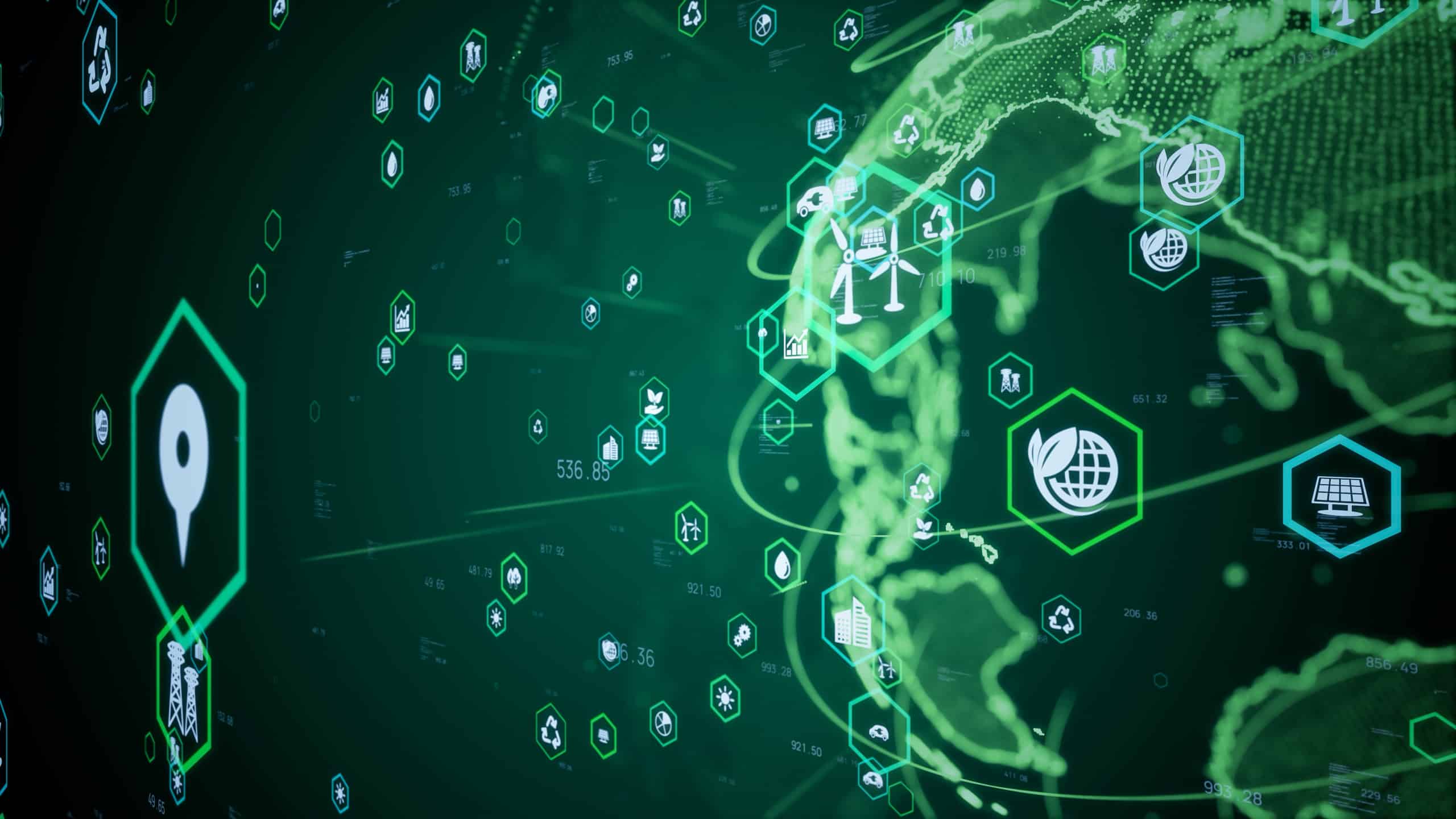Sustainability, the driving force behind eco-friendly practices, has risen as the paramount concern in supply chains. A spotlight now shines on the environmental impact of sourcing, production, and transportation.
Companies face immense pressure to reduce emissions, conserve resources, and promote fair labor practices. So, this shift stems from a growing consumer consciousness, regulatory demands, and a genuine desire to mitigate climate change.
Businesses grapple with striking a balance between cost efficiency and green operations. The complexity of supply chains makes this a daunting task.
You can use AI in your supply chain management to establish more efficient and sustainable operations in the future. AI is an excellent way to automate different processes, streamline operations, and strengthen security. It also ensures better use of raw materials for supply chain companies.
Research shows that AI can help companies adjust to shocks more efficiently and reliably. Thus, your company can become more sustainable through minimized turns and optimized routes.
The purpose is to ensure the least amount of goods/products usage, including oil utilization. A 2021 article by Forbes highlights that AI can reduce costs, improve efficiency, promote sustainability, and increase profits. Today’s article will discuss the role of AI in creating sustainable supply chains.
How AI and ML Assess Supply Chain Sustainability?
Assessing supply chain sustainability is crucial for several compelling reasons. First, it highlights environmental impact, allowing companies to identify areas of improvement and adopt greener practices.
Second, businesses can enhance their reputation by showcasing eco-friendly initiatives and catering to environmentally conscious consumers. Third, regulatory compliance is easier to achieve, avoiding potential fines and penalties.
Moreover, assessing sustainability encourages innovation, leading to more efficient processes and resource use. Companies that prioritize eco-friendliness often foster better relationships with stakeholders, including suppliers, customers, and investors.
Artificial intelligence and machine learning algorithms are excellent ways to assess supply chain sustainability. These modern technologies and mathematical models allow companies to generate data-driven insights and streamline all aspects of supply chain networks, from environmental policies to rerouting supply lines.
A research study published by IEEE XPLORE shows that companies designing and implementing Artificial Neural Network (ANN) and Decision Tree algorithms can evaluate their supply chain sustainability, including indicators like economy, society, and environment.
According to Supply Chain Digital, AI enables companies to work together, increasing sustainability in supply chain networks. It allows organizations to collaborate and share valuable data, enabling their teams to make more coordinated and informed decisions.
How can AI Optimize Supply Chain Routes?
Optimizing supply chain routes is vital for businesses thriving in today’s competitive landscape. Companies can significantly reduce operational costs, fuel consumption, and greenhouse gas emissions by streamlining transportation.
Efficient routes enable faster deliveries, ensuring happy customers and a positive brand image. Optimized logistics led to more predictable transit times, enhanced inventory management, and minimized stockouts or overstocks.
Well-planned routes alleviate the stress on transportation infrastructure and reduce traffic congestion. According to McKinsey, artificial intelligence can optimize supply chain routes by giving companies visibility into operations and helping them make informed decisions.
Because AI can analyze massive volumes of data, it enables you to understand data relationships, patterns, and insights, making it a potential game changer for supply chain managers and administrators.

According to Accenture, integrating an end-to-end approach is a reliable method for companies in the supply chain industry to address the opportunities and constraints of their business functions, including procurement and sales.
Besides, when you put data at the core of your supply chain network and apply AI and ML algorithms at scale, you can create a systematic and connected supply chain network without discrepancies.
What is the Role of AI in Carbon Emissions Reduction?
Carbon emissions can negatively impact your supply chain network in several ways. Elevated emissions contribute to climate change, leading to extreme weather events that disrupt logistics and damage infrastructure.
As regulations tighten, companies with high carbon footprints face increased scrutiny, potential fines, and reputational damage. Consumer preferences are also shifting towards eco-friendly options, making it crucial to align with their values.
Businesses with high emissions are less attractive to investors seeking environmentally responsible partners. By addressing carbon emissions in your supply chain, you protect the environment and future proof your business and improve overall performance.
A 2021 study published by BCG highlights that AI can substantially reduce carbon emission levels in supply chains because it can deliver deep insights into your company’s carbon footprint.
At the same time, AI can provide you with data you can use to cut costs and accelerate sustainable transformation. The study further states that incorporating AI technology can reduce greenhouse gas emissions by 5% to 10%.
According to ARS TECHNICA, AI-based systems can track carbon pollution throughout the supply chain and ensure companies take necessary measures to promote sustainability and practice ESG principles.
How Does AI Impact Sustainable Procurement and Supplier Selection?
According to Procurement Tactics, sustainable or green procurement integrates environmental, social, and governance aspects into a company’s procurement and supply chain.
In other words, it is how your business identifies and reduces the supply chain’s environmental, societal, and governance-related aspects and takes necessary actions to mitigate risks and improve operations.
A behavioral study published by Science Direct states that sustainable supplier selection is essential for companies in the supply chain network, focusing on supply chain partners with a practical commitment to sustainable practices.
You can apply specific mathematical models and economic frameworks to achieve long-term goals. GEP highlights that AI automates routine tasks, improves decision-making, decodes complex datasets, and provides actionable insights, transforming all aspects of procurement operations.

McKinsey highlights that AI systems can analyze massive volumes of data and generate valuable insights, allowing a company to understand relationships and leverage visibility into operations.
According to the PROCHE, machine learning algorithms can help companies analyze supplier data and determine which suits their specific requirements. AI uses mathematical models and predictive analysis to forecast supplier performance, identify potential risks, and provide insights that can help you reduce issues and streamline operations.
Research highlights that AI uses advanced systems and algorithms that reduce the risk of human error in supplier selection. The reason is that AI automates repetitive tasks and provides a more objective assessment of suppliers. The purpose is to remove human bias and ensure the selection process remains transparent and reliable.
How to Use AI for Real-Time Supply Chain Performance?
Real-time supply chain performance is essential for your company. With good insight, your decision-making becomes nimble, allowing you to pivot and adapt to the ever-changing business landscape.
Next, customer satisfaction comes into play. Customers expect nothing less than timely deliveries and swift resolutions in today’s fast-paced world. By having real-time information at your fingertips, you can ensure orders reach their destinations promptly and handle any hiccups with grace.
This, in turn, fosters trust and loyalty among your customers. Efficiency also takes center stage. With a real-time view of your supply chain, you can optimize processes, minimize waste, and identify cost-saving opportunities.
So this ultimately translates to a leaner, more profitable operation, giving you a competitive edge in the market. Let’s not forget risk management. By monitoring your supply chain in real-time, you can detect potential disruptions, such as supplier bottlenecks, transportation delays, or even geopolitical risks.
A study published by BCG highlights that AI can optimize a company’s supply chain performance in real-time because you can train AI algorithms to react to unforeseen circumstances and leverage data sets to make better decisions.

According to Deloitte, machine learning algorithms trained on massive volumes of data can handle near-term demand-to-supply discrepancies and imbalances. At the same time, they can trigger automated responses.
So this allows your company to minimize costs and maximize service. For example, Microsoft’s Copilot uses generative artificial intelligence to help supply chain teams by providing them with real-time data and insights.
How can AI Predict and Prevent ESG Issues?
Environmental and social risks in supply chains encompass potential negative consequences arising from business operations, impacting the environment, communities, and individuals involved in producing and distributing goods and services. These risks can create far-reaching effects for both the planet and society.
A primary environmental risk in supply chains is pollution, manifesting as air, water, and soil contamination from industrial processes or transportation. Greenhouse gas emissions from factories and vehicles contribute to climate change, while improper waste disposal harms ecosystems and human health.
Deforestation represents another significant environmental risk involving the large-scale clearing of forests for agricultural or industrial activities. This process results in habitat destruction, biodiversity loss, and increased carbon emissions, all contributing to climate change and ecosystem imbalance.
Social risks within supply chains include labor rights violations like child labor, forced labor, and subpar working conditions. Such practices exploit vulnerable workers, often in developing countries, perpetuating poverty and social inequality and causing physical and mental health problems.
Displacement of local communities is another social risk, occurring when land and resources are appropriated for industrial or agricultural purposes without fair compensation or consultation. Displacement can lead to social unrest, cultural identity loss, and heightened poverty.
Businesses must recognize and address these environmental and social risks in their supply chains, ensuring sustainable and ethical practices while minimizing their negative impact on the planet and society.
In the long term, this strategy benefits the environment, communities, and companies, as they build a reputation for responsible practices and attract environmentally and socially conscious consumers.
You can use AI-based systems to promote ESG in the supply chain by transforming the methods that address ESG-related problems. A 2022 article by Forbes highlights that AI can help organizations meet and beat their ESG goals using datasets and organized information extracted from volumes of data via advanced algorithms and predictive models.
According to World Quant, AI systems benefit investors and risk managers who analyze environmental, societal, and governance data. AI can collect unstructured data and transform it into structured formats, making it easier for investors and managers to reduce risks and optimize operations.
Another research report highlights that supply chain management solutions based on AI have become potent instruments for companies to handle various challenges, including sustainability problems.
A 2022 study shows that companies can leverage AI and make recurring decisions by identifying and recognizing patterns in big data. Remember, this is something human beings can’t do. However, organizations must deploy AI-based learning systems with integrated functions to unlock their full potential.
According to Venture Beat, ESG has become more critical in supply chain operations, and current policy adoption rates provide companies with plenty of room for growth.
Can You Use AI to Manage Sustainable Logistics and Transportation?
Artificial Intelligence can help organizations optimize routes by identifying and analyzing weather conditions, traffic patterns, and other factors affecting delivery times. It helps businesses reduce fuel consumption and carbon emission by focusing on delivery trucks taking efficient routes.
Vehicle performance optimization is another method companies can use to reduce fuel consumption, and this becomes more efficient via AI-based systems. For example, an AI-based system connected with sensors on delivery trucks can analyze data and identify areas of improvement for fuel efficiency.
Moreover, reducing waste via AI-based systems is an excellent way to manage sustainable logistics and transportation. AI algorithms connected with delivery trucks’ sensors can identify areas of waste generation.
In that case, companies can take necessary actions by leveraging data and identifying areas to reuse and recycle packaging materials. Furthermore, AI can help organizations manage their operations by improving safety.
What are Supply Chain Traceability and Transparency Using AI?
A 2022 study published by MDPI shows that supply chain traceability and transparency using AI refer to using artificial intelligence technologies to monitor, track, and provide visibility into the production, distribution, and sourcing of goods and services.
These advanced tools enable companies to understand better and control their supply chains, ensuring responsible and sustainable practices. Traceability in supply chains involves tracking the movement of products, materials, and components throughout the production process, from raw material sourcing to the finished goods reaching consumers.

According to Harvard Business Review, AI-powered systems can collect, process, and analyze vast amounts of data from various sources, such as IoT sensors and GPS tracking devices, to provide real-time information on the location, condition, and quality of items within the supply chain.
On the other hand, transparency refers to the openness and accessibility of information about supply chain practices, including environmental and social aspects.
By leveraging AI, companies can analyze data from multiple sources, including supplier self-assessments, third-party audits, and on-site inspections, to generate comprehensive and accurate insights into their suppliers’ environmental and social performance. AI-driven traceability and transparency initiatives offer several benefits to businesses, including:
Improved Risk Management: AI can help identify potential environmental and social risks within supply chains, enabling companies to address these issues proactively and mitigate their impact.
Enhanced Reputation: Demonstrating responsible and ethical practices through supply chain transparency can boost a company’s reputation, attracting environmentally and socially conscious consumers and investors.
Regulatory Compliance: AI-powered traceability ensures adherence to industry standards and regulations, reducing the likelihood of fines, penalties, or sanctions.
Increased Efficiency: By streamlining data collection and analysis, AI can identify inefficiencies in supply chains, allowing companies to optimize operations and reduce costs.
Strengthened Supplier Relationships: Transparency fosters trust and collaboration between businesses and their suppliers, encouraging adoption of sustainable and ethical practices throughout the supply chain.
Can Blockchain Technology Improve Supply Chain Traceability and Transparency?
Blockchain technology can improve supply chain traceability and transparency by providing a secure, decentralized, and tamper-proof platform for recording and sharing data related to the production, distribution, and sourcing goods and services.
Enhanced Traceability
Blockchain enables the tracking of products, materials, and components throughout the entire supply chain process, from raw material sourcing to the finished goods reaching consumers.
Each transaction, movement, or change in ownership is recorded as a block on the blockchain, creating a digital ledger that verifies the provenance and history of items, ensuring accurate and reliable information.
Improved Transparency
According to Forbes, blockchain’s decentralized nature allows for greater visibility and accessibility of supply chain data, promoting openness and accountability among businesses, suppliers, and consumers. All parties can access and verify the information stored on the blockchain, fostering trust and collaboration while encouraging ethical and sustainable practices.
Increased Security
Blockchain’s cryptographic features make it resistant to tampering and fraud. Once a transaction is recorded on the blockchain, it is nearly impossible to alter or delete, ensuring the integrity and authenticity of supply chain data.
Streamlined Processes
Blockchain technology can automate and simplify supply chain processes, reducing paperwork, manual input, and errors. Smart contracts, for example, can automatically execute transactions based on predefined conditions, increasing efficiency and reducing costs.
Enhanced Collaboration
Blockchain can facilitate better communication and collaboration among supply chain stakeholders, as all parties can access the same reliable and up-to-date information. This shared platform can improve decision-making and promote adopting sustainable and ethical practices across the supply chain.
Final Words
Artificial intelligence has emerged as a paramount catalyst for developing sustainable supply chains. By integrating advanced technologies, AI enables unprecedented efficiency, transparency, and resilience, transforming traditional operations into sophisticated, eco-conscious networks.
AI-powered tools enhance decision-making through data-driven insights, promoting cost-effectiveness and resource optimization. The unparalleled predictive capabilities of machine learning models foster proactive risk mitigation, bolstering the adaptability of supply chains in a volatile global landscape. Contact us today for more information!













































